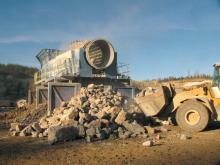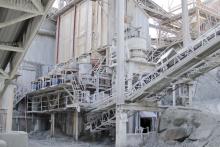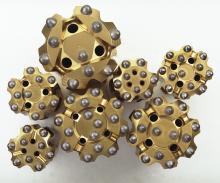Europe's railways rely on high quality aggregate to maintain both line speeds and passenger comfort. ABE reports on the technical aspects of railway ballast
The importance of aggregates to producing durable road surfacings is well publicised but the key role that quarried products play in Europe's rail network is less well known. While demand compared to roads is lower, the European rail network accounts for around 300million tonnes of aggregate demand each year for maintenance.
This aggregate is used in the form of rail ballast to support the track and spread the load of trains as they traverse the line. As with road surfacing, aggregate shape and quality are key characteristics in maintaining the ballast's ability to support the weight and offer free draining.
"The purpose of having rail ballast is to transfer the dynamic load from the sleepers and distribute the stress evenly but to do this the track bed need to resist permanent deformation and allow water to drain away," said Scott Wilson Rail Engineering principal engineer Paul Edwards.
"Aggregates used for rail ballast need be selected to provide the right level of interlocking to prevent deformation and need to resist flaking in order to maintain that interlock." The thickness of the ballast track bed will depend on the size and spacing of the sleepers, as well as traffic volume and weight. On high speed lines the track bed may be up to 500mm thick and on minor lines with minimal traffic it may only be 300mm deep. On ground were vibration may be an issue - either due to soft subsoil or nearby structures, the track bed is usually laid over a geo-membrane.
Aggregates used for track bed construction often have a nominal size of between 28 and 50mm, with an angular shape to provide interlock and minimise movement.
Service life of a granular track bed is dependent on the frequency and load placed on it, but the mineralogy of the aggregate will have a big influence on this. In Europe, most rail ballast is formed from igneous rocks to offer the maximum service life and minimise the need for maintenance.
Nonetheless, some countries do not have sufficient resources locally available and limestone is occasionally used but this type of ballast usually has a shorter service life.
"The usual design aim for a track is 25 years but that is dependent on a number of factors, including the rails, sleepers and ballast," said Scott Wilson Rail Engineering technical director Matt Brough. "But it is generally the ballast that has the shortest service life and the specification of the ballast will also influence the overall track service life.
"There used to be a culture of excavating out worn ballast and replacing it with new material but the industry is moving towards trying to extend the service life through maintenance and make the best use of the materials already in place. This is partly due to environmental pressures and cost control but reuse also helps to reduce the logistics issues and the length of track possessions."
Maintenance
There are maintenance techniques that can extend the service life of rail ballast.
"One of the biggest problems with ballast is the ingress of fines into the voids between the aggregate, which can be caused by silty material washing through the ballast or soil being pushed into the track bed from below," said Edwards. "This may cause the ballast to start to hold water and change its reaction under dynamic load." There are a number of rail based systems in operation around Europe that can undertake cleaning of the ballast in situ, which allow the line to be re-opened quickly. A ballast cleaning train works by excavating ballast from beneath the track while holding the track in its correct position. The machine passes the excavated material through large vibrating sieves, removing damaged ballast, or 'fines', to specialist wagons in the train, before returning the larger pieces of ballast to the track. Finally, the machine then adds new ballast from wagons to make up for the 'fines' removed.
"Tamping of the ballast is often used to re-compact the track bed," said Brough. "While this helps to improve the performance of the ballast, the act of tamping can actually accelerate the degradation of the aggregate." Tamping of the rail ballast is often combined with realignment of the rails to ensure that the cant and twist of the track stays within acceptable levels and the ride quality is maintained. Tamping can usually be carried out at a rate of 1.2km/hour.Concrete solution
Aggregate based track beds have been used in Europe since railways were first developed in the 1800s. But in the last decade there has been a move towards using concrete track slab technology, particularly on newly developed high speed rail lines.
Track slabs are either pre-cast or cast in situ, depending on the performance demands of the track and location, and need to be more highly engineered that a ballast based track bed. However, while the capital investment costs of a track slab are high, the long term maintenance is minimal.
"The investment costs and engineering involved in installing concrete track slabs means that they are better suited to new rail lines rather than part of maintenance on existing ones," said Brough. "Germany has been an early adopter of concrete track slabs and other rail networks in Europe are starting to follow suit."
"Another technique that is gaining acceptance for ballast maintenance is stone blowing," said Brough. "This approach uses a blow tube is used to inject pea sized gravel into the ballast to fill the voids and maintain the integrity of the track bed. This can add three or four years to the service life."
Waste not
Once the rail ballast has reached the end of its design life, the material is removed and replaced with fresh aggregates. According to Edwards, a certain percentage of the rail ballast can be recycled for use in other applications but the material needs to undergo a grading and testing programme first.
"There is a possibility that the ballast may be contaminated with pollutants such as hydrocarbons," he said. "The material must be tested under waste acceptance criteria to establish whether it is suitable for re-use or if it must be disposed of at landfill." Rail ballast that has been given a clean bill of health can be used for almost any application and there have been a number of projects that have successfully re-crushed ballast for use in road construction as both sub-base and asphalt.









